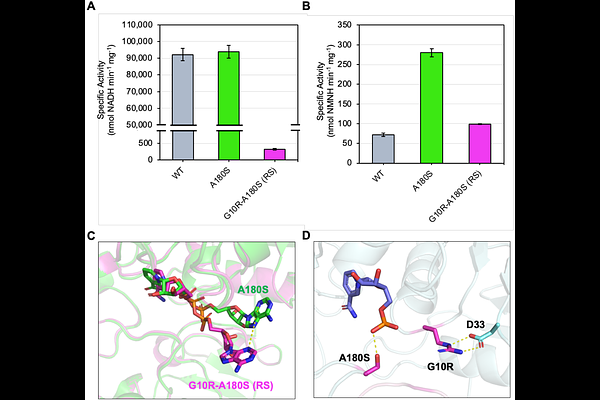Engineering the key central metabolic enzyme to utilize a non-canonical redox cofactor

Engineering the key central metabolic enzyme to utilize a non-canonical redox cofactor
Kim, J. Y.; King, E.; Cui, Y.; Zhang, L.; Siegel, J. B.; Li, H.
AbstractRedesigning central metabolism enzymes to utilize non-canonical cofactors that are orthogonal to NAD+ and NADP+ may allow partitioning of reducing power into a distinct redox cofactor pool that is preserved for user-desired biosynthetic tasks, without being dissipated by the complex natural metabolism in the cells. Here, we engineer Escherichia coli glyceraldehyde-3-phosphate dehydrogenase (GapA), the key enzyme in glycolysis, to utilize nicotinamide mononucleotide (NMN+) while greatly reducing its original activity with its native cofactor, NAD+. Through rational design, we identify the variant A180S with a ~3-fold increase in NMN+ specific activity compared to that of the wildtype (WT). Next, we design a double mutant, G10R-A180S (RS), where G10R mutation hampers the catalytic efficiency for NAD+ but also decreased the activity toward NMN+. Importantly, based on the hypothesis that the role of NAD+ in coordinating oligomer interface must be recapitulated in NMN+-utilizing enzymes, we develop a triple mutant G10R-A180S-G187Q (RSQ). Rosetta modeling predicts that the new mutation G187Q bridges separate subunits across the cofactor binding pocket, which possibly affords stronger association of the GapA tetramer, the active form of this enzyme. This final GapA variant features a ~2.8 x 104 switch of cofactor specificity from GapA\'s natural cofactor NAD+ to the non-canonical cofactor NMN+. Overall, this work demonstrates the engineering of a highly conserved, central metabolic enzyme for the utilization of a non-canonical redox cofactor NMN+. The design principle discovered here may be broadly applicable to many enzymes that bind cofactors using an intersubunit pocket.